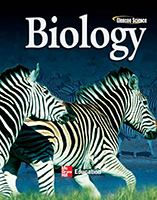Aaron J. Powner, M.Ed.
High School Science Teacher
 You Are Here | home › courses › biology
You Are Here | home › courses › biology
Biology
High school Biology curriculum is organized around three concepts: (1) the structures in all living things occur as the result of necessary functions, (2) interactions of organisms in an environment are determined by the biotic and abiotic components of the environment, and (3) evolution of species occurs over time and is related to the environment in which species live. Students will identify major natural patterns in living systems. Also, they will compare and contrast representatives of each category of living things.
Biology Syllabus
Biology Curriculum Expectations
Biology Textbook
 |
 |
Click Here ... Online PDF Textbook |
Term 3 Assignments:
Assignment 1: Participation/Citizenship
- Based on daily observations of behavior, increasing or decreasing frequently
- Reflected by a 4-point scale as follows:
- 4 = Honors - exceptional participation (more than expected), helpful, never distracts others
- 3 = Satisfactory - expected participation, cooperative, rarely distracts others
- 2 = Needs improvement - less than expected participation, less cooperative, occasionally distracts others
- 1 = Unacceptable - poor participation, defiant behavior, major source of distraction to others
Assignment 2: Fetal Pig Dissection Packet
Assignment 3: Fetal Pig Dissection Practical Exam
- Study from Dissection Packet or Virtual Dissection
- Make appointment with Mr. Powner or Miss Anna to make this up if you were absent
- SPECIAL NOTE: Students were allowed to retake this test once. They were taught how to study and were given all tools needed to succeed (see Fetal Pig Dissection Packet). Emails were sent home to inform parents/guardians of the need to prepare for this exam.
Assignment 4: Anatomy & Physiology (A&P) Notes
- Download the Physiology Notes Template | Word | PDF |
- Use the information contained in Unit 9 of the Textbook (chapters 32 - 37) to identify the main functions of all body systems and the specific functions of all major organs.
- You may use authoritative Internet sources to help you explain the functions of organs and systems, but keep it simple (at the high school level) or I may dock you major points for plagiarizing (copy and paste IS cheating).
- You may choose to list disorders and diseases for each system for extra credit.
- You may choose to do this as a presentation with pictures for extra credit.
- SPECIAL NOTE: Students were given two weeks to work on this assignment. Several periods were devoted to just this classwork. Various activities, discussions, and games were used to help students learn all the body systems and major organ functions. If they waited until the last minute to do this, we are sure they felt overwhelmed. Never-the-less, a working knowledge of general anatomy and physiology of body systems is foundational for the rest of this semester.
Assignment 5: Cell Reproduction Flashcards
- Make vocabulary flashcards for the following 12 words (instructions follow)
- Parent Cell, Daughter Cell, Chromosomes, Chromatin, Cell Cycle, Interphase, Mitosis, Cytokinesis, Prophase, Metaphase, Anaphase, Telophase
- Write vocabulary word on the front of each card. On the back, define the term in your own words and then draw a picture that relates to the term. See an example layout for vocabulary flashcards.
- Resource: Khan Academy Videos
- Resource: Chapter 09 of Textbook
Assignment 6: Punnett Square Worksheet
Bonus Assignment 7: Frankenstein Opinion
- Read Mary Shelley's novel entitled Frankenstein, or The Modern Prometheus
- Write a brief report with three parts:
- Venn Diagram - Compare and contrast the characters of Dr. Frankenstein and the Creature
- One Paragraph - Answer the question, "Who was the monster?" State your personal opinion and support it with reasons.
- One Paragraph - Explain how the ideas presented in this 1811 novel apply to a modern genetics concept (pick one from the list below) taught by Mr. Powner and Miss Anna. Remember the phrase, "Just because you can do something doesn't always mean you should."
- treating genetic diseases/disorders (gene therapy)
- creating designer babies
- cloning
- ethics and consequences of attempting to control human genetic evolution
Assignment 7: Plants Ch. 21 Section Reviews (All 4 Sections)
Assignment 8: Plants Lab
- Part 1 - Flower Dissection Diagram (10 points)
- Labeled drawing of 3 species of flowers (crocus, daffodil, columbine).
Use the generic flower diagram to identifying the following parts of the three species
- Pistil (femail parts: stigma, style, ovary)
- Stamen (male parts: anther, filament, pollen)
- Petals
- Sepals
- Part 2 - Microscopy Diagram (10 points)
- Labeled drawing of three tissue types
- leaf section with parenchymal cells
- stem/trunk section with collenchymal cells
- root section with sclerenchymal cells
- Part 3 - Participation (10 points)
Lesson: Introduction of the Evolutionary Theory


![]() You Are Here | home › courses › biology
You Are Here | home › courses › biology